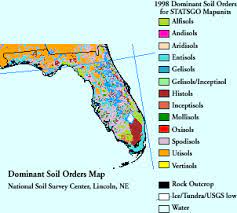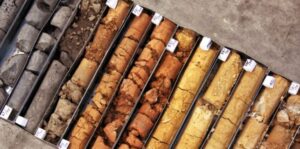FLORIDA SOILS
FLORIDA DEPARTMENT OF HEALTH
BASIC SOILS

SOIL DEFINED
DEFINITION of soil. SOIL is the collection of dynamic natural bodies, at or near the earth’s surface, made up of earthy materials and supports or is capable of supporting plant growth. For the purpose of soil survey investigations, the soil is usually described to a depth of 80 inches, or to hard bedrock, whichever comes first. –Derived from Soil Taxonomy.
The methods described in this manual are used to predict the properties of the soil as it is defined above. These methods may not support the definition or concepts of soil used by other disciplines. Most persons think of soil as being a substance. In our definition, soil is part of the planet, just as a mountain or lake is part of the planet. We cannot hold a mountain in the palm of our hands nor can we hold the soil in our
hands. We must examine the soil outdoors, where it has formed. We can however, remove a sample from the soil and take it to a laboratory to analyze.
Exclusions To The Definition
We can further clarify our concept of soil by discussing the nature of things that are both included and excluded from the definition. For example, the material that we purchase in plastic bags called “potting soil” is excluded from the definition. Although it can support plants and is made up of earthy materials, it is not a part of the earth’s surface. The sediment at the bottom of a lake or the ocean is excluded from the definition. This is geologic material from which a soil might later form if the sea level drops sufficiently. Excavated fill material is excluded from the definition. It can be the material that once was part of a soil, but after excavation it is no longer part of the earth’s surface. Per USDA NRCS guidelines, if the fill material can support plant growth after it is placed, it becomes a new layer of a soil.

Essential Elements In The Definition
Soil Material. Soil material is the substance from which soil is made. The components of soil material are discussed in the next chapter of this manual.
Landforms. Soils are on LANDFORMS, or segments of natural landscapes such as dune swales, hill slopes, river terraces, cypress domes, or coastal plain flats.
Soil Genesis. Soils FORM or develop over time from geologic and biological material that is called PARENT MATERIAL. Some types of parent material are ocean deposits, rock that has been weathered in place, windblown sands or silts, minerals carried by a river and deposited on a floodplain, and decayed plant materials. Many soils form in materials derived from several kinds of parent materials such as ocean deposits and decayed plant materials. The natural processes that change parent material into soil material are collectively referred to as SOIL GENESIS. Some of the processes of soil genesis include biochemical alteration of substances, accumulation of humus and other materials
on the soil surface and the movement of substances and particles through a soil by percolating rainwater.
Soil Morphology. The characteristics of a soil that form and can be observed are referred to as the MORPHOLOGY of the soil. When a person conducts an onsite investigation of a soil, he or she is looking for morphological features that will help predict certain physical and chemical properties of a soil. For example, the color pattern of a soil is a morphological feature that can help one predict the depth to the
seasonal high water table (even if the observation is made during the dry season).
Soil Horizons. The primary morphological unit in a soil is called a HORIZON. A soil horizon is a layer that is nearly parallel to the soil surface. Some soil horizons are easy to distinguish from another horizon that lies above or below because there is a distinct boundary between the two layers. Other horizons change so gradually with depth that it is difficult to determine their boundaries.
COMPONENTS OF SOIL
There are four basic components of soil. These are minerals, organic matter, water, and gases.
Mineral Type vs. Size. Mineral material is the most abundant component of most soils. Two important ways to classify minerals are by the SIZE of the mineral particle and by the TYPE of the mineral particle. The most common type of mineral in Florida soils is quartz. For the purpose of making most Onsite Sewage Treatment and Disposal System (OSTDS) land use decisions, particle SIZE is the mineral classification scheme that is most important to consider.
Three Mineral Sizes. The three basic sizes of soil mineral particles are SAND size, SILT size, and CLAY size. Each basic particle size has distinguishing properties that can be observed even when the individual particles cannot be seen.
Sand. Soil minerals are essentially weathered rock. The forces of nature, over time, have split and crushed rocks until they have become the size of a SAND grain. SAND is the largest soil particle. Sand ranges in size from 0.05 millimeters to 2.0 millimeters in diameter. Individual sand particles can be seen by the naked eye. Sand feels gritty when rubbed, and barely holds together when moist. Water moves through sand
rapidly to very rapidly. Sand is nearly inert (it has very low chemical activity). It supplies few or no nutrients to plants.
Sand Size Subdivisions. The sand particle can be subdivided into more detailed classes. These are very coarse sand, coarse sand, medium sand, fine sand, and very fine sand. Very coarse sand particles are about the size of a lower case alphabetic character produced by a standard typewriter. Medium sand particles are about the size of a sugar grain. Fine sand particles are about the size of pin point or the diameter of a strand of hair. Individual particles of very fine sand are difficult to see without the aid of a magnifying glass. Fine sand and Medium sand (medium sand is referred to simply as “sand”) are the most common of the sand sizes that are found in Florida soils. Coarser sands are not common in Florida soils but are sometimes found on banks of swift flowing rivers and on beaches.
Silt. The SILT sized particle is intermediate in diameter between sand and clay. If you were able to smash a sand grain with a hammer until it became powdery, you would have created silt particles. The diameter of an individual silt particle is 0.002 to 0.05 millimeters. Individual particles of silt are difficult to see without magnification. When moist, silt feels smooth and silky. It holds together well when molded, but cannot be formed into a RIBBON. (A ribbon is a thin, flat, elongated form that can be molded from materials containing clay).
Silt is somewhat chemically active. In Florida, soils dominated by silt are not common. They are primarily found on the floodplains of large rivers, in some tidal marshes, and in broad areas of the southernmost part of the Florida Peninsula.
Clay. The smallest soil mineral particle is the CLAY sized particle. Individual particles of clay have diameters that are smaller than 0.002 millimeters. Individual particles of clay are so small that they can only be viewed using powerful microscopes. Clay is chemically active, and may provide a large amount of nutrients to plants. Water moves slowly through materials dominated by clay particles. Clay is easily molded into shapes, or into a long ribbon that will hold together without easily breaking. It may be sticky when moist.
It is rare to find soil materials that are pure silt or pure clay (nearly pure sand is common). Most soil materials are a mixture of the three particle sizes. For example, a soil layer might contain material that is 75 percent sand, 10 percent silt, and 15 percent clay. We refer to this mixture of particle sizes as SOIL TEXTURE.
Soil Minerals: Texture Field vs. Laboratory Determination. Soil texture can be accurately determined in the laboratory using various measuring techniques or soil texture can be estimated in the field by rubbing a MOIST sample between the fingers. It is generally impractical, time consuming, and costly to send permit site samples to the laboratory; however with practice, the field estimate can be quite
accurate, and acceptable for the planning of onsite sewage treatment and disposal systems.
Texture and Soil Properties. Because each different size of mineral particle has unique properties, soil material that is a mixture of sand, silt, and clay will have properties that are influenced by each of the different particle sizes. For example, soil material that is 40 percent sand, 40 percent silt, and 20 percent clay will have some grittiness, like sand; some stickiness, like clay, and be able to hold a substantial amount of
water, like silt.
The Textural Triangle. In order to simplify the description of particle size mixtures, a system was developed called the USDA SOIL TEXTURAL CLASSIFICATION. In this scheme, twelve classes of soil texture are depicted on a 3-axis graph called the USDA SOIL TEXTURAL TRIANGLE.
USDA Textural Classes. A LOAM is a mixed textural class that has properties nearly equally derived from each of the three particle sizes. Loam is somewhat gritty, a bit sticky, yet also smooth when rubbed. It contains 7 to 27 percent clay, 28 to 50 percent silt, and less than 52 percent sand. Note that the Loam class is located at the lower center of the textural triangle. Other textural classes are positioned to the left, right, or above the loam class on the textural triangle. Classes to the left of loam contain a higher percentage of sand particles; classes to the right contain a higher percentage of silt particles and classes above contain a higher percentage of clay particles. For soil materials that are dominantly sand, dominantly silt, or dominantly clay, there are soil textural classes by the same name of the dominant particle: the SAND class, the SILT class, and the CLAY class. The SAND textural class contains mostly sand particles, but may contain some silt particles and clay particles. Similarly, the SILT textural class, contains mostly silt particles, and the CLAY textural class contains mostly clay particles.
Other soil textural classes include SILT LOAM, CLAY LOAM, and SANDY LOAM; LOAMY SAND, SANDY CLAY, and SILTY CLAY; SANDY CLAY LOAM and SILTY CLAY LOAM.
Common Soil Textures in Florida. The most common soil textures in Florida are fine sand, sand, loamy fine sand, loamy sand, fine sandy loam, sandy loam, sandy clay loam, and sandy clay. On occasion, the textures clay, clay loam, and loam are encountered. In most parts of the state, it is extremely rare to find soil materials with textures silt loam, silty clay loam, silty clay, and silt. Note that the most commonly occurring textures in Florida are those depicted on the lower left corner of the USDA TEXTURAL TRIANGLE.
